
Timely Comics is the common name for the group of corporations that was the earliest comic book arm of American publisher Martin Goodman, and the entity that would evolve by the 1960s to become Marvel Comics.

Journey into Mystery is an American comic book series initially published by Atlas Comics, then by its successor, Marvel Comics. Initially a horror comics anthology, it changed to giant-monster and science fiction stories in the late 1950s. Beginning with issue #83, it ran the superhero feature "The Mighty Thor", created by writers Stan Lee and Larry Lieber and artist Jack Kirby, and inspired by the mythological Norse thunder god. The series, which was renamed for its superhero star with issue #126, has been revived three times: in the 1970s as a horror anthology, and in the 1990s and 2010s with characters from Marvel's Thor mythos. The title was also used in 2019 for a limited series as part of the "War of the Realms" storyline.
Strange Tales is a Marvel Comics anthology series. The title was revived in different forms on multiple occasions. Doctor Strange and Nick Fury, Agent of S.H.I.E.L.D. made their debuts in Strange Tales. It was a showcase for the science fiction/suspense stories of artists Jack Kirby and Steve Ditko, and for the groundbreaking work of writer-artist Jim Steranko. Two previous, unrelated magazines also bore that title.
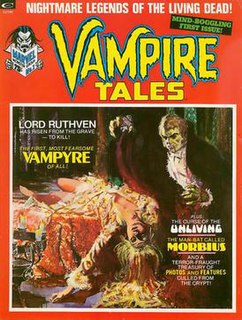
Vampire Tales was an American black-and-white horror comics magazine published by Magazine Management, a corporate sibling of Marvel Comics. The series ran 11 issues and one annual publication from 1973 to 1975, and featuring vampires as both protagonists and antagonists.

Eugene Jules Colan was an American comic book artist best known for his work for Marvel Comics, where his signature titles include the superhero series Daredevil, the cult-hit satiric series Howard the Duck, and The Tomb of Dracula, considered one of comics' classic horror series. He co-created the Falcon, the first African-American superhero in mainstream comics; Carol Danvers, who would become Ms. Marvel and Captain Marvel; and the non-costumed, supernatural vampire hunter Blade.

Stephen Ross Gerber was an American comic book writer best known for co-creating the satiric Marvel Comics character Howard the Duck and a character-defining run on Man-Thing, one of their monster properties. Other notable works include Omega the Unknown,Marvel Spotlight: "Son of Satan", The Defenders,Marvel Presents: "Guardians of the Galaxy", Daredevil and Foolkiller. Gerber was known for including lengthy text pages in the midst of comic book stories, such as in his graphic novel, Stewart the Rat. Gerber was posthumously inducted into the Will Eisner Comic Book Hall of Fame in 2010.
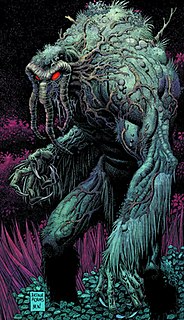
The Man-Thing is a fictional character appearing in American comic books published by Marvel Comics. Created by writers Stan Lee, Roy Thomas, and Gerry Conway and artist Gray Morrow, the character first appeared in Savage Tales #1, and went on to be featured in various titles and in his own series, including Adventure into Fear.
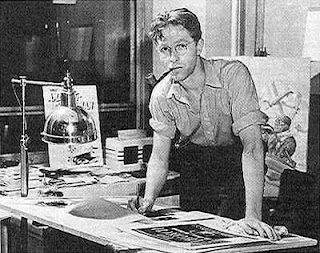
William Blake Everett was an American comic book writer-artist best known for creating Namor the Sub-Mariner as well as co-creating Zombie and Daredevil with writer Stan Lee for Marvel Comics. He was allegedly a descendant of the childless poet William Blake and of Richard Everett, founder of Dedham, Massachusetts.

Adventure into Fear is an American horror comic book series published by Marvel Comics from cover dates November 1970 through December 1975, for 31 issues. This is its trademarked cover title for all but its first nine issues, though the series is copyrighted in its postal indicia as simply Fear.
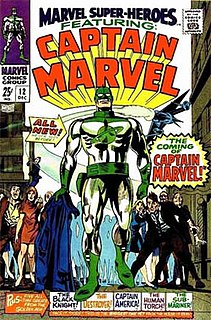
Marvel Super-Heroes is the name of several comic book series and specials published by Marvel Comics.
Pablo Marcos Ortega, known professionally as Pablo Marcos, is a comic book artist and commercial illustrator best known as one of his home country Peru's leading cartoonists, and for his work on such popular American comics characters as Batman and Conan the Barbarian, particularly during the 1970s. His signature character was Marvel Comics' the Zombie, for which Marcos drew all but one story in the black-and-white horror-comics magazine Tales of the Zombie (1973–1975).

The Zombie is a fictional supernatural character appearing in American comic books published by Marvel Comics. The character was created by writer Stan Lee and artist Bill Everett for the standalone story "Zombie" in the horror-anthology comic book Menace #5, which was published by Atlas Comics, a forerunner to Marvel. The character later became well known for starring in the black-and-white horror-comic magazine series Tales of the Zombie (1973–1975), usually in stories by Steve Gerber and Pablo Marcos.
Marvel Tales is the title of three American comic-book series published by Marvel Comics, the first of them from the company's 1950s predecessor, Atlas Comics.
Notable events of 1975 in comics. See also List of years in comics.

The Savage Sword of Conan was a black-and-white magazine-format comic book series published beginning in 1974 by Curtis Magazines, an imprint of American company Marvel Comics, and then later by Marvel itself. Savage Sword of Conan starred Robert E. Howard's most famous creation, Conan the Barbarian, and has the distinction of being the longest-surviving title of the short-lived Curtis imprint.
Monsters Unleashed is the title of an American black-and-white comics magazine published by Magazine Management and two color comic-book miniseries from Marvel Comics. The first ran from 1973 to 1975. The two miniseries ran consecutively in 2017.

Horror comics are comic books, graphic novels, black-and-white comics magazines, and manga e.g. focusing on horror fiction. In the US market, horror comic books reached a peak in the late 1940s through the mid-1950s, when concern over content and the imposition of the self-censorship Comics Code Authority contributed to the demise of many titles and the toning down of others. Black-and-white horror-comics magazines, which did not fall under the Code, flourished from the mid-1960s through the early 1980s from a variety of publishers. Mainstream American color comic books experienced a horror resurgence in the 1970s, following a loosening of the Code. While the genre has had greater and lesser periods of popularity, it occupies a firm niche in comics as of the 2010s.
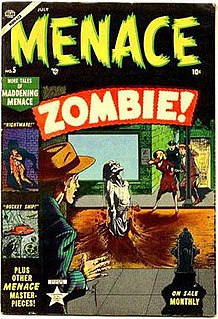
Menace was a 1953 to 1954 American crime/horror anthology comic book series published by Atlas Comics, the 1950s precursor of Marvel Comics. It is best known for the first appearance of the supernatural Marvel character the Zombie, in a standalone story that became the basis for the 1970s black-and-white comics magazine Tales of the Zombie. As well, a standalone story in the final issue introduced a robot character that was revived decades later as the Human Robot, a.k.a. M-11, the Human Robot.

Dracula Lives! was an American black-and-white horror comics magazine published by Magazine Management, a corporate sibling of Marvel Comics. The series ran 13 issues and one Super Annual from 1973 to 1975, and starred the Marvel version of the literary vampire Dracula.














